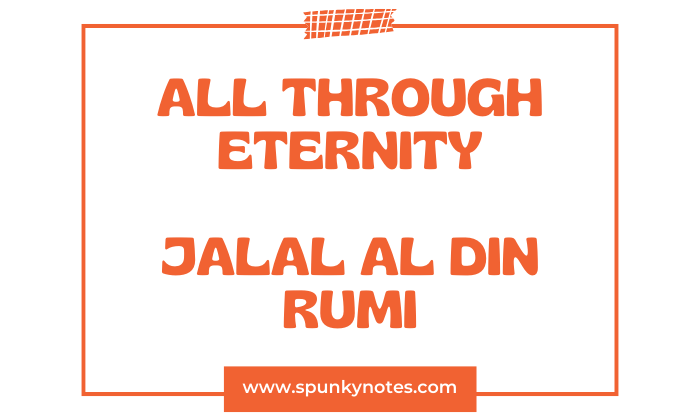 Q. Critically explain the poem All Through Eternity by Rumi.
Q. Critically explain the poem All Through Eternity by Rumi.
“All Through Eternity” by Jalaluddin Rumi is a poem about divine love’s enduring and powerful nature. Rumi suggests that this kind of love lifts the soul to new heights, fills individuals with immense joy, and even shields them from death.
The poem describes a moment where death, upon encountering someone filled with divine love, realizes it cannot prevail. It highlights that spiritual love is stronger than death and can lead to eternal life.
Explanation of All Through Eternity
Stanza 1
All through eternity
Beauty unveils His exquisite form
in the solitude of nothingness;
He holds a mirror to His Face
and beholds His own beauty.
he is the knower and the known.
the seer and the seen;
No eye but His own
has ever looked upon this Universe.
Explanation
The first stanza of Rumi’s poem is about the divine entity in a state of solitude and self-contemplation. It exists beyond human understanding, described as “nothingness,” signifying a state of pure essence before creation.
All through eternity
This line emphasizes the eternal existence of the divine, which transcends time and is always present.
Beauty unveils His exquisite form in the solitude of nothingness
Divine beauty represents the attributes of God. Rumi describes the divine alone in a void, emphasizing that it creates everything from nothing.
This line suggests that in the emptiness of the void, without any distractions, the true beauty of the divine becomes apparent.
He holds a mirror to His Face and beholds His own beauty
This image shows the divine looking at itself in a mirror, both seeing and being seen. It suggests a moment where the divine reflects on its own beauty and existence, representing deep self-understanding.
He is the knower and the known, the seer and the seen
It shows the divine as both the observer and the one being observed. They describe how the divine completely understands itself, embodying the observer and what’s observed.
No eye but His own has ever looked upon this Universe
This line points out that only the divine has truly seen the universe. It stresses that the divine alone creates and understands everything, showing its unique and all-powerful role.
Stanza 2
His every quality finds an expression:
Eternity becomes the verdant field of Time and Space;
Love is the life-giving garden of this world.
Every branch, leaf, and fruit
Reveals an aspect of His perfection:
The cypress gives a hint of His majesty.
The rose gives tidings of His beauty.
Explanation
The second stanza shifts focus to manifesting divine attributes in the created world. Eternity, a concept beyond human grasp, becomes tangible in the “verdant field of time and space.” This suggests that the universe, with its vastness and continuous change, reflects the divine’s infinite nature.
Love, described as the “life-giving garden of this world,” is portrayed as the vital force that sustains and nourishes all creation. The imagery of every branch, leaf, and fruit reveals an aspect of divine perfection.
The cypress tree symbolizes majesty, and the rose represents beauty, illustrating how even seemingly disparate elements of the natural world express the divine’s attributes.
His every quality finds an expression:
This line suggests that the attributes of the divine manifest in various forms throughout the world, allowing us to see and experience the divine qualities in our surroundings.
Eternity becomes the verdant field of Time and Space;
In this line, eternity is visualized as a lush, green field stretching across time and space. It suggests that the timeless and eternal nature of the divine merges with the physical world, creating a space where life and experiences can flourish.
Love is the life-giving garden of this world.
Love is compared to a garden that brings life to the world. This metaphor highlights love as a vital force that nurtures and sustains life, similar to how a garden supports the growth and health of its plants.
Every branch, leaf, and fruit
Reveals an aspect of His perfection:
It emphasizes that each natural element, from branches to leaves to fruits, displays a different facet of the divine’s perfection. Nature serves as a living in all its detail and variety, indicating the divine’s flawless characteristics.
The cypress gives hint of His majesty
The cypress tree is used to symbolize the divine’s majesty. Its tall, straight stature and enduring nature are symbols of strength and royal grandeur, representing the majestic side of the sacred.
The rose gives tidings of His beauty
The rose is portrayed as a symbol of the divine’s beauty. Its appealing appearance, pleasant scent, and overall grace make it an emblem of the divine’s aesthetic perfection, offering a beautiful and gentle reminder of the divine’s presence.
Stanza 3
Whenever Beauty looks,
Love is also there.
Whenever beauty shows a rosy cheek,
Love lights Her fire from that flame.
When beauty dwells in the dark folds of night,
Love comes and finds a heart
entangled in tresses.
Beauty and Love are as body and soul.
Beauty is mine, and love is the diamond.
Explanation
Whenever Beauty looks, Love is also there.
Love is always present wherever Beauty is observed. It suggests an automatic and intrinsic connection between the two—where there is an appreciation of beauty, love naturally follows.
This connection implies a universal truth within the human experience, where to perceive beauty is also, in some way, to feel love.
Whenever beauty shows a rosy cheek,
Love lights Her fire from that flame
In this imagery, beauty is likened to a rosy cheek, a classic symbol of vitality and allure. Love, in response, is described as lighting its fire from the glow of this beauty.
This metaphor of fire and flame conveys beauty’s energizing effect on love, sparking its passion and warmth.
When beauty dwells in the dark folds of night,
Love comes and finds a heart entangled in tresses.
In Sufism, beauty often represents the divine. The phrase about beauty dwelling in darkness suggests the hidden and mysterious aspects of the divine, which are always present but not easily seen or understood.
Love symbolizes a seeker’s spiritual longing for God. Despite being entangled by worldly distractions (represented by the tresses), divine love still reaches and awakens the seeker.
This shows that divine love can penetrate any barriers to reach those who seek it. The tresses or hair often symbolize worldly attachments or sins that may entangle the heart, challenging the path to divine love.
In Sufi belief, the heart is more than an organ; it’s the center of spiritual understanding and connection with God. When love reaches the heart, it marks a moment of spiritual awakening, where the seeker begins to connect with and truly feel the presence of the divine.
Beauty and Love are as body and soul.
This line suggests that Beauty and Love are deeply connected and essential to each other, similar to how the body and soul are linked in a human being.
Beauty and love cannot be separated; they rely on each other to be fully expressed and understood. The body gives physical form to the soul’s intentions, and in the same way, Beauty makes Love visible and tangible.
Likewise, the soul gives purpose and meaning to the body, just as Love enhances and enriches the experience of Beauty. This comparison highlights the strong bond and interdependence between Beauty and Love. It indicates that one cannot truly exist or be appreciated without the other.
Beauty is mine, and love is the diamond.
Beauty often represents the divine presence or attributes of God. When the speaker says, “Beauty is mine,” it suggests a deep personal connection to the divine.
It could mean that the speaker feels an intimate bond with God, seeing divine beauty reflected in their existence and the world around them.
It reflects that by purifying the self and seeking closeness to God, one can experience divine beauty within themselves and their surroundings.
Love is the soul’s longing and devotion to God. Love as a diamond emphasizes its preciousness, purity, and enduring nature.
Just as a diamond is rare and valuable, so is true divine love. It should be sought after, cherished, and valued above all else. The metaphor highlights the transformative power of love, which, like a diamond, can cut through the hardest of obstacles and shine brightly.
Stanza 4
They are together
since the beginning of time
Side by side, step by step.
Explanation
It shows that beauty and love have existed together from the beginning. This indicates that these two concepts are inherently linked and have continuously accompanied each other.
Their relationship is constant and unchanging, with Beauty and Love progressing in perfect harmony and unity.

